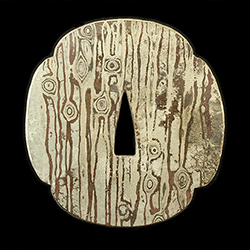The craftsman of the Mokume Gane, Kunio Takada, persists in creating
an engagement ring and two wedding bands from a plate of the Mokume
Gane, as the craftsman ponders a precious encounter and knot between 2
persons after having arrangements with them for sizes and designs of
rings.
To Mr. Suzuki, who invented it, and the Japanese craftsmen that
have been succeeding to the arts and craftsmen… like the craftsmen of
our studio: Mokume Gane no Takada Co., Ltd. and those who are, right
now, reading this Web Site, there is a knot for all. The Mokume Gane
rings are now encountering you. The different kinds of metal plates are
stacked, and come upon together. Like many years in your marriage life
for the future, the layers of annual growth rings of a wood on these
rings, also, nestle together. In our unique world, a pair of rings is
completed.
What’s the Mokume Gane?
The Mokume Gane is the kind of metal or the art that enables to
show the figures of annual growth rings of a wood applying the
surpassing characteristics of precious metal, such as malleability and
plasticity after combining different kinds of metals.
Mr. Suzuki (the Japanese Craftsman’s name: Shoami Denbei lived in
Dewa Akita) born in 1651 invented Mokume Gane in the beginning of the
Edo Period. He was the craftsman for decorations of the Japanese sword
(Katana) and for armor of Samurai.
A billet of metal, heated at high temperature and turned to a red
color, is beaten and tempered by hammer, and this process is repeated.
And then, the billet beaten to be thin is carved by chisel. Making it
thinner appears finally the different colors of metal stacked together
as a pattern of annual growth rings of a wood.
By the way, the word, called “Mokume Gane”, is not made recently,
but the word was used for a long time ago, because the word is written
on the various old Japanese documents

The Origin of the Mokume Gane
Before the origin of the Mokume Gane, there is, in china, a skill
of digging into the lacquers painted by several layers with the colors
of black, yellow, and cinnabar red. The skill, called Guri-Bori, creates
a swirling pattern and an arabesque design for a set of utensils for
the Chinese tea. In the Muromachi period, the skill of Guri-Bori was
informed in Japan with the utensils. It seems that the Chinese skill
became a clue to have developed how to use it in metal for decorated
parts of the Japanese sword.
Shoami Denbei lived in Dewa Akita (his own name: Suzuki), which
is his artist name, invented the Mokume Gane. He was born in 1651. He
became a disciple of the Shoami Family, which is a school of the
craftsman in the Edo Period, and learned the skill in Edo (right now,
Tokyo). He moved to Akita prefecture, and then became famous as a Mokume
Gane craftsman of the Japanese sword “Katana” and armor of Samurai
after working as a main contractor for making them at the feudal clan of
Satake.
The Crisis of the Mokume Gane
In 1876, an edict prohibiting the wearing of swords was issued.
Many craftsmen of the Mokume Gane were unable to have a job and stop
making it. The traditional art was broken off at that time.
In the Showa period, although some Mokume Gane were restored from
old documents and some remained items as samples, most of the Japanese
people did not know about the art because the craftsmen were rare.
After that, The Mokume Gane, the Japanese tradition used for
Katana and armor of Samurai, started to become famous in the U.S. and
the world. The recognition of the art has prevailed over the world much
faster than in Japan. Nowadays, it starts to be more popular in Japan.
The Usage of the Mokume Gane
The Mokume Gane was often used for the Japanese armor and Katana
that feudal lords and powerful Samurai possess in the Edo period when
the art was completed. It presented the various shades of colors at
rates changed mainly to mix Gold, Silver and Cupper. Nowadays, it is
used for wedding bands and an engagement ring, accessories, tea sets,
receptacles for Sake, vases of flower, kitchen utensils, and so on. As
for wedding bands, these rings are often made of Platinum and K18 Gold
with different colors.
【References】April 9, 2000 Asahi Journal-Tokyo
Zone/Akita 29 page, September 1, 2001 Asahi Journal-Tokyo Zone/Akita 32
page, August 28, 2004 Asahi Journal-Tokyo Zone /Akita 26 page, November
6, 2009 Asahi Journal-Osaka Zone /Ishikawa 30 page, October 19, 2005
Asahi Journal-Akita 26 page, the four seasons of precious stones No.198,
No.199: Folklore of the Arts, About the technique of Mokume Gane – the
Art Manual Series – Jewelry Crafts of Metal.
